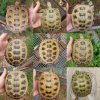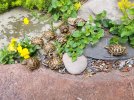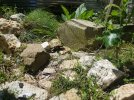I know there has been some talk about genetic testing of the more 'fancy' tortoise breeds. Well, since Russian tortoises are my jam, I decided to have my Russian tortoises genetically tested, too (the results are at the very end, if you don't want to read the long story). And since it is my hope that other tortoise breeders will jump on the band-wagon and have theirs tested, I decided to write down the info here.
When I built my original founder group (from Craigslist tortoises!), I visually matched the adults, based on shell shape, coloration, and the configuration of their plastron scutes. I was fairly sure that they were all the same subspecies, but I wasn't confident WHICH one (I thought either T.h.horsfieldii or T.h.kazachstanica).
I lost a few of my founder group to a raccoon in WA a year before we moved to AR. I also decided that I didn't want the remaining wild-caught adults to have to adjust to yet another climate. So before moving, I rehomed the remaining WC adults and only moved with the CB group (one or two babies from each of my females, all the same father, plus 2 little CB males I got from trusted breeder friends).
Here is a photo of my little CB group. They range from 10 years old to 5years, except for the one at the bottom right, which is a 2-year-old CB2.

I wanted to know the subspecies of my tortoises for sure so that I can produce subspecies-pure progeny. We all know how e.g. leopard tortoises were imported to the US and interbred willy-nilly, and now we have a schmorgas of leopard mutts. The same thing is happening with Russian tortoises.
I produce about 9-15 baby Russian tortoises per year, with three more young CB females coming up to breeding size in the next year or two. Knowing the subspecies of my Russian tortoises allows me to breed with conservation of the species in mind.

I learned about the GENDIKA laboratory in the Netherlands from my tortoise buddy, Matthew Hills. They do genetic testing of many animals. (GENDIKA) (set it to 'English' in your browser or use Google translate). I reached out to them and inquired whether they are able to determine the subspecies of Russian tortoises.
As it turns out, YES, they are able to, and they were able to tell me the subspecies, the clade, and the specific locality my tortoises originated from! It cost me EUR60 (about $55 at the time) per tortoise, plus $25 for USPS priority mail. I had 7 of them tested, since of my 8 adults, two are full siblings.
Some notes:
Gendika needs buccal swabs for the genetic sequencing and subspecies determination. A buccal swab is a non invasive way to get a tissue sample from the inside of the tortoise's cheek.
PS: If you don't have experience (man)handling tortoises, you should have a vet do the buccal swab. A lot can go wrong if you don't know how. To do this yourself, you need to know how to safely hold the tortoise's head out, and how to safely open their mouth.
I am lucky to have over a decade of experience doing beak maintenance on tortoises for a rescue, so I was confident I could do it without harming the tortoises.
It takes 2 people. One holds the tortoise like a burger. The other (me) catches the tortoise's neck on either side (NOT top and bottom) between thumb and pointer, right behind the jaw. The tortoise gets mad and pees all over the person holding them. If you're lucky, the tortoise opens its mouth at you and you can pop that swab right into their mouth (5 of the 7 did this). If you are not lucky, the tortoise clamps its mouth shut (2 of the 7 did this). I used a plastic dental tool to carefully pry the mouth open, and held it open by keeping the tool in its mouth like a bit on a horse. You will feel like you don't have enough hands and will probably be
 on. A 3rd person might be useful, if only to video your swearing.
on. A 3rd person might be useful, if only to video your swearing.

Once the swab is within the V of the tortoise's jaw, you can let the head go. Keep the swab IN the tortoise's mouth when it retracts its head. You swipe the swab on the inside of its cheeks and on its tongue with a twirling motion, about 10-15 seconds of swab and swirl.
You have to leave the tubes slightly open for a few days to let the sample dry. It's illegal to ship wet samples.
PS: I have since learned that it would have been BETTER to go through a local veterinary school or animal biology department at our local university, since they have specific export permits. There are some strict laws about exporting animal tissues. So while (as seen below) there are codes etc. you put on the shipping envelope, it could have still been stopped by customs. Let's keep things legal!
I talked to AR Fish and Wildlife, and to the lead clerk at USPS about how to ship the samples. I was told: The sample tubes have to be inside a bag inside the envelope, and everything is properly labeled "UN3373 Biological Substance Category B" (label from Gendika) and "Research sample for vet" and "No commercial value" on the outside, plus signed customs form with value $1. You need to include an HS Tariff code. Based on my research, 3001.20.00 (tissue sample from animal) is the closest approximation. My package still sat in customs in the Netherlands for three weeks, but then it moved along to Gendika. I paid for the order AFTER Gendika sent me an email confirming that they received the samples.
These are the sterile, individually wrapped sample swabs I used: Swabs
They worked well, the tip did not lose any pieces or fibers into the tortoise's mouth.
Ok, so after all this TLDR, you're probably wondering what the subspecies of my tortoises are? Here you go:

I was so pleased to find out that they are all of the same subspecies (Testudo h. kazachstanica) and clade (red). And it was cool to look at a world map and see exactly where their parents originated from. My husband's reaction: "WHAT? We have Iranians in our house?" My answer: "They were born in the US. That's good enough for me."
I hope more Russian tortoise breeders (and breeders of other species, too!) will have their tortoises' DNA sequenced so we can produce more subspecies-pure progeny.

When I built my original founder group (from Craigslist tortoises!), I visually matched the adults, based on shell shape, coloration, and the configuration of their plastron scutes. I was fairly sure that they were all the same subspecies, but I wasn't confident WHICH one (I thought either T.h.horsfieldii or T.h.kazachstanica).
I lost a few of my founder group to a raccoon in WA a year before we moved to AR. I also decided that I didn't want the remaining wild-caught adults to have to adjust to yet another climate. So before moving, I rehomed the remaining WC adults and only moved with the CB group (one or two babies from each of my females, all the same father, plus 2 little CB males I got from trusted breeder friends).
Here is a photo of my little CB group. They range from 10 years old to 5years, except for the one at the bottom right, which is a 2-year-old CB2.

I wanted to know the subspecies of my tortoises for sure so that I can produce subspecies-pure progeny. We all know how e.g. leopard tortoises were imported to the US and interbred willy-nilly, and now we have a schmorgas of leopard mutts. The same thing is happening with Russian tortoises.
I produce about 9-15 baby Russian tortoises per year, with three more young CB females coming up to breeding size in the next year or two. Knowing the subspecies of my Russian tortoises allows me to breed with conservation of the species in mind.

I learned about the GENDIKA laboratory in the Netherlands from my tortoise buddy, Matthew Hills. They do genetic testing of many animals. (GENDIKA) (set it to 'English' in your browser or use Google translate). I reached out to them and inquired whether they are able to determine the subspecies of Russian tortoises.
As it turns out, YES, they are able to, and they were able to tell me the subspecies, the clade, and the specific locality my tortoises originated from! It cost me EUR60 (about $55 at the time) per tortoise, plus $25 for USPS priority mail. I had 7 of them tested, since of my 8 adults, two are full siblings.
Some notes:
Gendika needs buccal swabs for the genetic sequencing and subspecies determination. A buccal swab is a non invasive way to get a tissue sample from the inside of the tortoise's cheek.
PS: If you don't have experience (man)handling tortoises, you should have a vet do the buccal swab. A lot can go wrong if you don't know how. To do this yourself, you need to know how to safely hold the tortoise's head out, and how to safely open their mouth.
I am lucky to have over a decade of experience doing beak maintenance on tortoises for a rescue, so I was confident I could do it without harming the tortoises.
It takes 2 people. One holds the tortoise like a burger. The other (me) catches the tortoise's neck on either side (NOT top and bottom) between thumb and pointer, right behind the jaw. The tortoise gets mad and pees all over the person holding them. If you're lucky, the tortoise opens its mouth at you and you can pop that swab right into their mouth (5 of the 7 did this). If you are not lucky, the tortoise clamps its mouth shut (2 of the 7 did this). I used a plastic dental tool to carefully pry the mouth open, and held it open by keeping the tool in its mouth like a bit on a horse. You will feel like you don't have enough hands and will probably be


Once the swab is within the V of the tortoise's jaw, you can let the head go. Keep the swab IN the tortoise's mouth when it retracts its head. You swipe the swab on the inside of its cheeks and on its tongue with a twirling motion, about 10-15 seconds of swab and swirl.
You have to leave the tubes slightly open for a few days to let the sample dry. It's illegal to ship wet samples.
PS: I have since learned that it would have been BETTER to go through a local veterinary school or animal biology department at our local university, since they have specific export permits. There are some strict laws about exporting animal tissues. So while (as seen below) there are codes etc. you put on the shipping envelope, it could have still been stopped by customs. Let's keep things legal!
I talked to AR Fish and Wildlife, and to the lead clerk at USPS about how to ship the samples. I was told: The sample tubes have to be inside a bag inside the envelope, and everything is properly labeled "UN3373 Biological Substance Category B" (label from Gendika) and "Research sample for vet" and "No commercial value" on the outside, plus signed customs form with value $1. You need to include an HS Tariff code. Based on my research, 3001.20.00 (tissue sample from animal) is the closest approximation. My package still sat in customs in the Netherlands for three weeks, but then it moved along to Gendika. I paid for the order AFTER Gendika sent me an email confirming that they received the samples.
These are the sterile, individually wrapped sample swabs I used: Swabs
They worked well, the tip did not lose any pieces or fibers into the tortoise's mouth.
Ok, so after all this TLDR, you're probably wondering what the subspecies of my tortoises are? Here you go:

I was so pleased to find out that they are all of the same subspecies (Testudo h. kazachstanica) and clade (red). And it was cool to look at a world map and see exactly where their parents originated from. My husband's reaction: "WHAT? We have Iranians in our house?" My answer: "They were born in the US. That's good enough for me."
I hope more Russian tortoise breeders (and breeders of other species, too!) will have their tortoises' DNA sequenced so we can produce more subspecies-pure progeny.
